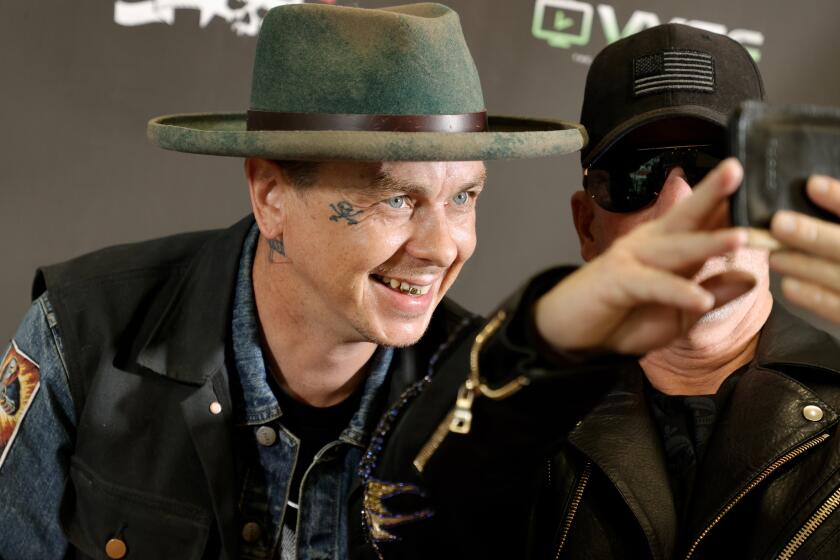Latino Artists Pack ‘Em In
When debonair Spanish crooner Julio Iglesias opens a two-night stand Friday at the Universal Amphitheatre, it’ll be a homecoming of sorts.
The international pop star has been headlining the 6,000-plus-seat facility regularly since he first played there in 1983.
At that time, Iglesias was a “test” booking to see whether Latin artists could draw in a facility that had been devoted almost exclusively to mainstream pop-rock.
Now, however, he is one of more than two dozen Latin performers headlining this year at the Universal and its chief rival the Greek Theatre (and other facilities operated by Nederlander Concerts, including the Pond of Anaheim).
The dramatic growth of Latin concerts in these traditionally “mainstream” theaters is a reflection of the region’s booming Latino population, which makes up nearly half of L.A. County’s population.
Iglesias’ son, 22-year-old Enrique Iglesias, sold out two 12,000-seat concerts at the Pond last month, while another father-son combination is on the way to Universal: Mexican mariachi king Vicente Fernandez (Nov. 21-23) and son Alejandro (Dec. 7).
Other upcoming Latin concerts include La Mafia (June 20), Emmanuel (June 28) and Viva Mariachi ’97 (Sept. 6) at the Greek and Rockinvasion ’97 (June 21-22), Lucero (July 12) and Juan Gabriel (Oct. 24-26) at the Universal.
In fact, nearly 20% of the concerts at the Greek and Universal this year feature Latin acts covering a variety of genres, including mariachi, tejano, pop, jazz, tropical and rock en espan~ol.
“Latin concerts are probably the most well-attended of any genre show we do,” said Larry Vallon, senior vice president of Universal Concerts.
It was Vallon who first booked Iglesias at the theater. Before 1983, artists that appealed to Spanish-speaking audiences tended to appear at smaller venues, such as the Million Dollar Theater downtown (for the past six years the home of a Spanish-language Protestant ministry).
“It took an artist that [appealed to a non-Latino audience] for us to have our eyes opened to the fact that Latinos were a segment of the community that would come out and spend money on tickets in a big way,” said Vallon, who booked Iglesias that first time for just two shows and ended up extending the engagement to five.
“We all knew at that point that we’d been missing the boat in servicing this area of the concert-going public,” he said. “Obviously there was some pent-up demand.”
It’s a demand that has also been manifesting itself in increased record sales in the United States.
“In listening to the manufacturers, there is a significant growth in Latin music sales,” said Mike Shallet, chief operating officer of SoundScan, the company that monitors album sales in the United States.
Shallet estimates that of the 233 million albums sold in the United States this year, 5 million are Latin--a figure nearly twice that of gospel and new age, and closing in on jazz (7.5 million) and classical (8.4 million). And SoundScan does not track sales at the non-traditional outlets--such as barbershops and swap meets--that are believed to account for far more sales in the Latin music world than in other fields. “We’re probably capturing anywhere from half to 65% of the volume [of Latin music sales],” Shallet said.
Susan Rosenbluth, vice president of Nederlander Concerts, also sees an increase in the number of concerts by Latin artists, and room for growth. The company’s Greek Theatre booked its first Spanish-language performer in 1984--Venezuelan soap opera and recording star Jose Luis Rodriguez.
“A William Morris talent agent came to us and said that the Latino population in L.A. is growing and we ought to start hosting shows of top name talents for them at the Greek,” Rosenbluth recalled of the signing. “We did it, and it sold out.”
Roberto Morgalo, who works with tropical artists in his position as a talent agent at the Latin division of Universal Attractions in New York, notes that the U.S. boom in Latin music concerts isn’t limited to Southern California.
“In New York, Latin shows regularly sell out at Madison Square Garden,” says Morgalo of the 18,200-seat arena. He also cites Miami, Orlando and Chicago as major cities for large-scale Latin concerts.
*
The key is figuring out which acts will do well in which cities. In Los Angeles, for example, the majority of Latinos are Mexican American or Mexican immigrants, with different musical tastes from Latinos in New York or Miami, where Puerto Rican and Cuban backgrounds dominate.
“Promoters want to do [Latin] events, but many don’t know enough about the music,” Morgalo said. “They think all Latin music is the same, and they have to really know and identify the different types of music and figure out how to make it successful.”
Another challenge is figuring out how to reach potential Latino concert-goers, many of whom are bilingual and tend to consume both Spanish- and English-language media.
Methods employed by Universal and Nederlander to track preferences include monitoring Latin music CD sales and ticket sales. Marketing and publicity efforts include radio promotions, ticket giveaways and advertising in both Spanish- and English-language publications and radio stations.
“KIIS-FM and Power 106 have been supportive by giving away tickets to various shows,” said Emily Simonitsch, who handles Hispanic booking and marketing at Universal. “[Many of] their listeners are bilingual, so [those English-language stations] want to be able to give away tickets to the Spanish shows.”
More to Read
The biggest entertainment stories
Get our big stories about Hollywood, film, television, music, arts, culture and more right in your inbox as soon as they publish.
You may occasionally receive promotional content from the Los Angeles Times.










